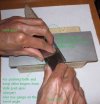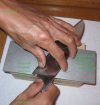- Joined
- Jul 15, 2012
- Messages
- 1,885
Freehand sharpening... What is your technique for maintaining a consistent angle?
The BladeForums.com 2024 Traditional Knife is available! Price is $250 ea (shipped within CONUS).
Order here: https://www.bladeforums.com/help/2024-traditional/
In my opinion, the answer is practice, practice, practice
I use a homemade jig with an adjustable angle. All I have to worry about is keeping the blade perpendicular to the floor.View attachment 389320
I try to keep my eyes a bit out of focus when sharpening, meaning I try to keep my focus on my fingertips and what I am feeling
Put the fingers of your off hand right on top of where you're grinding
Make the fingertips of the off hand the dominant force - they push/pull and inform the hand gripping the handle where the apex is/ what your angle needs to be/speed/pressure, the grip hand follows. Those fingertips are right on top of where the steel is moving across the abrasive
This is how I do it...


